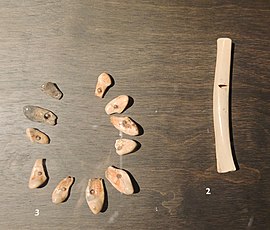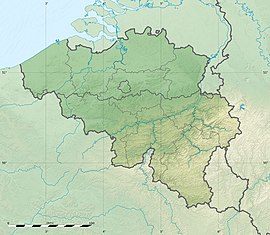Grottes de Goyet | |
 Finds from Goyet and Trou Magrite in the Museum for Natural Sciences of Belgium | |
| Alternative name | Caves of Goyet |
|---|---|
| Location | near Mozet village |
| Region | Samson river valley, Gesves municipality Namur province, Belgium |
| Coordinates | 50°26′48″N 5°00′32″E / 50.44667°N 5.00889°E |
| Type | carboniferous limestone |
| Length | 250 m (820.21 ft) |
| History | |
| Material | limestone Karst |
| Periods | Middle Palaeolithic to Iron Age |
| Cultures | Aurignacian, Gravettian, Magdalenian |
| Associated with | Neanderthals, Homo sapiens |
| Site notes | |
| Excavation dates | 1867, |
| Archaeologists | Edouard Dupont |
The Goyet Caves (French: Grottes de Goyet) are a series of connected caves located in Belgium in a limestone cliff about 15 m (50 ft) above the river Samson near the village of Mozet in the Gesves municipality of the Namur province. The site is a significant locality of regional Neanderthal and European early modern human occupation, as thousands of fossils and artifacts were discovered that are all attributed to a long and contiguous stratigraphic sequence from 120,000 years ago, the Middle Paleolithic to less than 5,000 years ago, the late Neolithic. A robust sequence of sediments was identified during extensive excavations by geologist Edouard Dupont, who undertook the first probings as early as 1867.[1][2] The site was added to the Belgian National Heritage register in 1976.
- ^ "The caves that prove Neanderthals were cannibals". Phys.org. Retrieved January 9, 2017.
- ^ "Goyet Cave (Belgium) - Evidence for Early Dog Domestication". Archaeology about com. Archived from the original on November 8, 2016. Retrieved January 9, 2017.

